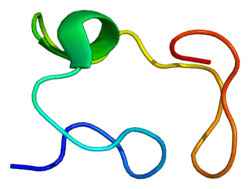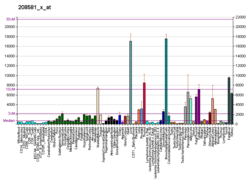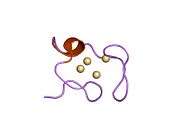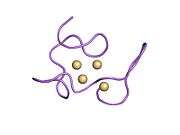MT1X
Metallothionein 1X, also known as MT1X, is a protein which in humans is encoded by the gene.[3][4][5]
See also
References
- 1 2 3 GRCh38: Ensembl release 89: ENSG00000187193 - Ensembl, May 2017
- ↑ "Human PubMed Reference:".
- ↑ "Entrez Gene: MT1X metallothionein 1X".
- ↑ West AK, Stallings R, Hildebrand CE, Chiu R, Karin M, Richards RI (November 1990). "Human metallothionein genes: structure of the functional locus at 16q13". Genomics. 8 (3): 513–8. doi:10.1016/0888-7543(90)90038-V. PMID 2286373.
- ↑ Stennard FA, Holloway AF, Hamilton J, West AK (August 1994). "Characterisation of six additional human metallothionein genes". Biochim. Biophys. Acta. 1218 (3): 357–65. doi:10.1016/0167-4781(94)90189-9. PMID 8049263.
Further reading
- West AK, Stallings R, Hildebrand CE, et al. (1991). "Human metallothionein genes: structure of the functional locus at 16q13". Genomics. 8 (3): 513–8. doi:10.1016/0888-7543(90)90038-V. PMID 2286373.
- Stennard FA, Holloway AF, Hamilton J, West AK (1994). "Characterisation of six additional human metallothionein genes". Biochim. Biophys. Acta. 1218 (3): 357–65. doi:10.1016/0167-4781(94)90189-9. PMID 8049263.
- Pauwels M, van Weyenbergh J, Soumillion A, et al. (1994). "Induction by zinc of specific metallothionein isoforms in human monocytes". Eur. J. Biochem. 220 (1): 105–10. doi:10.1111/j.1432-1033.1994.tb18603.x. PMID 8119276.
- Mididoddi S, McGuirt JP, Sens MA, et al. (1996). "Isoform-specific expression of metallothionein mRNA in the developing and adult human kidney". Toxicol. Lett. 85 (1): 17–27. doi:10.1016/0378-4274(96)03632-6. PMID 8619255.
- Holloway AF, Stennard FA, West AK (1997). "Human metallothionein gene MT1L mRNA is present in several human tissues but is unlikely to produce a metallothionein protein". FEBS Lett. 404 (1): 41–4. doi:10.1016/S0014-5793(97)00082-3. PMID 9074634.
- Garrett SH, Somji S, Todd JH, et al. (1999). "Differential expression of human metallothionein isoform I mRNA in human proximal tubule cells exposed to metals". Environ. Health Perspect. Brogan &. 106 (12): 825–32. doi:10.2307/3434126. JSTOR 3434126. PMC 1533231. PMID 9831543.
- Hellemans G, Soumillion A, Proost P, et al. (2000). "Metallothioneins in human kidneys and associated tumors". Nephron. 83 (4): 331–40. doi:10.1159/000045425. PMID 10575295.
- Garrett SH, Sens MA, Shukla D, et al. (2000). "Metallothionein isoform 1 and 2 gene expression in the human prostate: downregulation of MT-1X in advanced prostate cancer". Prostate. 43 (2): 125–35. doi:10.1002/(SICI)1097-0045(20000501)43:2<125::AID-PROS7>3.0.CO;2-S. PMID 10754528.
- Vandeghinste N, Proost P, De Ley M (2000). "Metallothionein isoform gene expression in zinc-treated human peripheral blood lymphocytes". Cell. Mol. Biol. (Noisy-le-grand). 46 (2): 419–33. PMID 10774930.
- Hartley JL, Temple GF, Brasch MA (2001). "DNA cloning using in vitro site-specific recombination". Genome Res. 10 (11): 1788–95. doi:10.1101/gr.143000. PMC 310948. PMID 11076863.
- Rahman MT, De Ley M (2001). "Metallothionein isogene transcription in red blood cell precursors from human cord blood". Eur. J. Biochem. 268 (3): 849–56. doi:10.1046/j.1432-1327.2001.01947.x. PMID 11168427.
- Garrett SH, Belcastro M, Sens MA, et al. (2001). "Acute exposure to arsenite induces metallothionein isoform-specific gene expression in human proximal tubule cells". J. Toxicol. Environ. Health Part A. 64 (4): 343–55. doi:10.1080/152873901316981321. PMID 11693492.
- Strausberg RL, Feingold EA, Grouse LH, et al. (2003). "Generation and initial analysis of more than 15,000 full-length human and mouse cDNA sequences". Proc. Natl. Acad. Sci. U.S.A. 99 (26): 16899–903. doi:10.1073/pnas.242603899. PMC 139241. PMID 12477932.
- Izmailova E, Bertley FM, Huang Q, et al. (2003). "HIV-1 Tat reprograms immature dendritic cells to express chemoattractants for activated T cells and macrophages". Nat. Med. 9 (2): 191–7. doi:10.1038/nm822. PMID 12539042.
- Anderson NL, Polanski M, Pieper R, et al. (2004). "The human plasma proteome: a nonredundant list developed by combination of four separate sources". Mol. Cell. Proteomics. 3 (4): 311–26. doi:10.1074/mcp.M300127-MCP200. PMID 14718574.
- Gerhard DS, Wagner L, Feingold EA, et al. (2004). "The status, quality, and expansion of the NIH full-length cDNA project: the Mammalian Gene Collection (MGC)". Genome Res. 14 (10B): 2121–7. doi:10.1101/gr.2596504. PMC 528928. PMID 15489334.
- Wiemann S, Arlt D, Huber W, et al. (2004). "From ORFeome to biology: a functional genomics pipeline". Genome Res. 14 (10B): 2136–44. doi:10.1101/gr.2576704. PMC 528930. PMID 15489336.
- Mehrle A, Rosenfelder H, Schupp I, et al. (2006). "The LIFEdb database in 2006". Nucleic Acids Res. 34 (Database issue): D415–8. doi:10.1093/nar/gkj139. PMC 1347501. PMID 16381901.
This article is issued from
Wikipedia.
The text is licensed under Creative Commons - Attribution - Sharealike.
Additional terms may apply for the media files.







